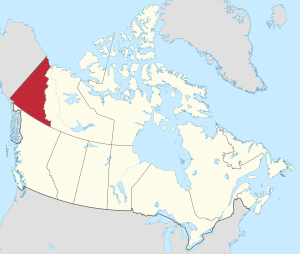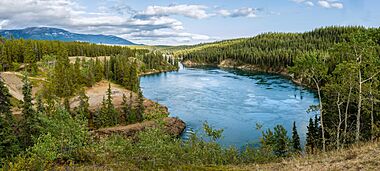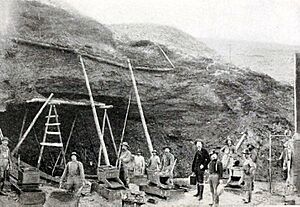Yukon facts for kids
Quick facts for kids
Yukon
|
|||
|---|---|---|---|
|
|||
| Country | Canada | ||
| Confederation | June 13, 1898 (9th) | ||
| Capital | Whitehorse | ||
| Largest city | Whitehorse | ||
| Largest metro | Whitehorse | ||
| Government | |||
| • Type | Parliamentary system | ||
| Area | |||
| • Total | 482,443 km2 (186,272 sq mi) | ||
| • Land | 474,391 km2 (183,163 sq mi) | ||
| • Water | 8,052 km2 (3,109 sq mi) 1.7% | ||
| Area rank | Ranked 9th | ||
| 4.8% of Canada | |||
| Population
(2021)
|
|||
| • Total | 40,232 | ||
| • Estimate
(Q2 2024)
|
45,750 | ||
| • Rank | Ranked 12th | ||
| • Density | 0.08/km2 (0.2/sq mi) | ||
| Demonym(s) | Yukoner FR: Yukonnais(e) |
||
| Official languages | |||
| GDP | |||
| • Rank | 13th | ||
| • Total (2017) | C$3.089 billion | ||
| • Per capita | C$75,141 (3rd) | ||
| HDI | |||
| • HDI (2021) | 0.930 — Very high ([[List of Canadian provinces and territories by Human Development Index|4th]]) | ||
| Time zone | UTC−07:00 | ||
| Postal abbr. |
YT
|
||
| Postal code prefix |
Y
|
||
| ISO 3166 code | CA-YT | ||
| Flower | Fireweed | ||
| Tree | Subalpine fir | ||
| Bird | Common raven | ||
| Rankings include all provinces and territories | |||
Yukon is Canada's smallest and most western territory. It used to be called the Yukon Territory. Even though it is the smallest, it has the most people among Canada's three territories. About 45,750 people lived there in 2024.
Whitehorse is the capital city of Yukon. It is also the largest city in any of Canada's territories. Yukon became a separate territory in 1898. Before that, it was part of the Northwest Territories.
The government officially changed the name to "Yukon" in 2002. However, many people still call it "the Yukon." The official postal code for the territory is "YT."
Yukon has two official languages: English and French. But the government also respects and supports the languages of the First Nations people who live there.
Yukon is home to Mount Logan, Canada's highest mountain. It stands at 5,959 meters (19,551 feet) tall. This huge mountain is found in Kluane National Park and Reserve. Most of Yukon has a subarctic climate. This means it has long, cold winters and short, warm summers. The area along the Arctic Ocean has a tundra climate, which is even colder.
Important rivers in Yukon include the Yukon River, Pelly River, Stewart River, and Peel River.
Contents
What Does "Yukon" Mean?
The name "Yukon" comes from the Yukon River. This is the longest river in the territory. The name comes from the Gwich'in phrase chųų gąįį han. This means "white water river." It describes the pale color of the water from melting glaciers in the Yukon River.
For a long time, people informally called the territory "The Yukon." In 2003, the government said it should just be called "Yukon." But many people still preferred "The Yukon." In 2021, the government decided to use "The Yukon" again in official materials.
Exploring Yukon's Geography
Yukon is shaped a bit like a triangle. It shares a border with the U.S. state of Alaska to the west. To the east, it borders the Northwest Territories. To the south, it borders British Columbia. Yukon's northern coast touches the Beaufort Sea.
Most of the territory is part of the Yukon River's watershed. This means that most of the water flows into the Yukon River. Southern Yukon has many large, long, and narrow lakes. These lakes are fed by glaciers and also flow into the Yukon River system. Some of the biggest lakes are Teslin Lake, Atlin Lake, and Kluane Lake.
Canada's highest point, Mount Logan, is in the southwest of Yukon. This mountain and a large part of the southwest are in Kluane National Park and Reserve. This park is a UNESCO World Heritage Site. Other national parks in Yukon are Ivvavik National Park and Vuntut National Park in the north. Another World Heritage Site, Tr'ondëk-Klondike, was named in 2023.
Common trees in Yukon are the black spruce and white spruce. Many trees are small because the growing season is short and the climate is harsh.
Yukon's Climate and Weather
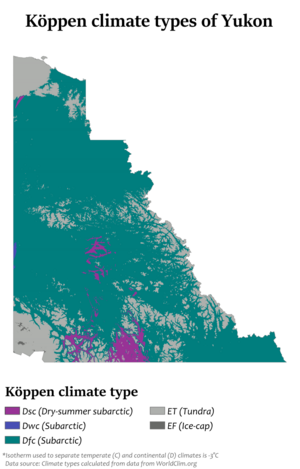
Yukon's winters are cold, but they are milder than some other parts of the Canadian Arctic. However, Yukon can get extremely cold during severe cold snaps. The temperature has dropped to -60°C (-76°F) three times in history. The coldest ever recorded was -63.0°C (-81.4°F) in February 1947 in the town of Snag.
Unlike most of Canada, Yukon's hottest days usually happen in June or even May. The temperature has reached 36°C (97°F) three times. The highest was 36.5°C (97.7°F) in June 2004 near Whitehorse.
| City | July Average High | July Average Low | January Average High | January Average Low |
|---|---|---|---|---|
| Whitehorse | 21 °C (70 °F) | 8 °C (46 °F) | −11 °C (12 °F) | −19 °C (−2 °F) |
| Dawson City | 23 °C (73 °F) | 8 °C (46 °F) | −22 °C (−8 °F) | −30 °C (−22 °F) |
| Old Crow | 20 °C (68 °F) | 9 °C (48 °F) | −25 °C (−13 °F) | −34 °C (−29 °F) |
A Look at Yukon's History
Long before Europeans arrived, First Nations people lived in central and southern Yukon. This area was not covered by glaciers during the last Ice Age. Because of this, important archeological sites in Yukon show some of the earliest signs of humans in North America. These sites help us learn about the first people and early First Nations of Yukon.
Around 800 AD, a volcanic eruption happened in Alaska. It covered southern Yukon with a layer of ash. You can still see this ash along the Klondike Highway today. This event is also part of the oral stories of First Nations people.
First Nations groups, both from the coast and inland, had large trading networks. Europeans started coming to the area in the early 1800s for the fur trade. Later, missionaries arrived. By the 1870s and 1880s, gold miners began to appear. This led to more people living in the area. A police force was needed, and it was set up just in time for the start of the Klondike Gold Rush in 1897. The large number of people who came for the gold rush led to Yukon becoming a separate territory in 1898.
Who Lives in Yukon?
The 2021 census counted 40,232 people living in Yukon. Yukon has a land area of about 474,712 square kilometers (183,287 square miles). This means it has the highest population density among Canada's three territories. Statistics Canada estimated that Yukon's population grew to 45,750 by 2024. This is a 17.5% increase since 2016, which is the biggest growth for any Canadian province or territory.
Unlike other parts of Canada, Statistics Canada counts the entire territory of Yukon as one large census area.
Yukon's Diverse Population
Visible minority and indigenous identity (2016): European Canadian (68.1%) Visible minority (8.5%) First Nations (19.1%) Métis (2.9%) Inuit (0.6%) Other Indigenous responses (0.8%)
In 2016, most of Yukon's population was of European background. However, there are also many First Nations communities throughout the territory. The 2011 National Household Survey looked at Yukon's different cultures and immigration. It found that 87.7% of residents were born in Canada. Also, 24.2% were of Indigenous (First Nations, Métis, or Inuit) background.
The most common countries where immigrants were born were the United Kingdom, the Philippines, and the United States. Among recent immigrants (from 2006 to 2011), most were born in Asia.
| Rank | Ethnic group | Population (2016) | Percentage |
|---|---|---|---|
| 1 | English | 9,680 | 27.57% |
| 2 | Aboriginal | 8,665 | 24.68% |
| 3 | Canadian | 8,640 | 24.61% |
| 4 | Scottish | 8,295 | 23.63% |
| 5 | Irish | 6,930 | 19.74% |
| 6 | German | 5,575 | 15.88% |
| 7 | French | 5,040 | 14.35% |
| 8 | Ukrainian | 2,200 | 6.27% |
| 9 | Dutch | 1,760 | 5.01% |
| 10 | Norwegian | 1,380 | 3.93% |
Languages Spoken in Yukon
|
|
||||||||||||||||||||||||||||||||||||||||||||||||||||||||||||||||||||
In the 2011 Canadian census, most people (82.9%) said English was their first language. French was the second most common first language (4.3%).
Yukon's Language Act recognizes the importance of the territory's Indigenous languages. These languages can be used in the Legislative Assembly. However, only English and French are used for laws and court cases.
Religious Beliefs in Yukon

The 2021 Canadian census showed that many Yukoners (59.7%) reported having no religious affiliation. This is the highest percentage in Canada. Christianity was the most common religion, reported by 35.0% of residents. Sikhism was next, at 1.0%.
| Religious Beliefs in Yukon (2021 Census) | ||
|---|---|---|
| Religion | Adherents | % of the Population |
| No religion and secular perspectives | 23,640 | 59.71% |
| Christian | 13,860 | 35.01% |
| Sikh | 380 | 0.96% |
| Traditional (North American Indigenous) spirituality | 325 | 0.82% |
| Hindu | 265 | 0.67% |
| Buddhist | 260 | 0.66% |
| Muslim | 185 | 0.47% |
| Jewish | 70 | 0.18% |
| Other religions and spiritual traditions | 600 | 1.52% |
| Total | 39,590 | 100% |
Yukon's Economy and Industries
Yukon's main industry is mining. They mine for lead, zinc, silver, gold, and copper. The Canadian government took over the land from the Hudson's Bay Company in 1870. They made Yukon a separate territory in 1898. This was because so many people came for the Klondike Gold Rush. Thousands of gold seekers moved to Yukon. This time in history is written about by authors like Robert W. Service and Jack London.
The history of the gold rush and the early days of the Royal Canadian Mounted Police are still remembered. Also, Yukon's beautiful scenery and outdoor activities make tourism its second most important industry.
Other important industries include manufacturing, which makes things like furniture, clothes, and crafts. Hydroelectricity (power from water) is also important. Older industries like trapping and fishing have become less common. As of 2012, the government itself employed about 6,300 people out of a total workforce of 20,800.
Tourism in Yukon
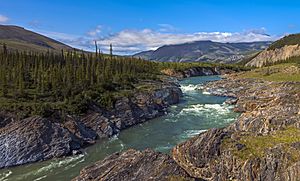
Yukon's tourism slogan is "Larger than life." The tourism industry relies a lot on Yukon's natural beauty. Many companies offer guided trips for activities like hunting, fishing, canoeing, kayaking, hiking, skiing, snowboarding, ice climbing, and dog sledding. You can do these activities with a guide or explore the backcountry on your own, often by air or snowmobile.
Yukon has many festivals and sporting events. These include the Adäka Cultural Festival, Yukon International Storytelling Festival, and the Yukon Sourdough Rendezvous. Because of Yukon's northern location, you can often see the amazing aurora borealis (Northern Lights).
The Yukon Government manages several territorial parks. These include Herschel Island Qikiqtaruk Territorial Park and Tombstone Territorial Park. Parks Canada, a federal agency, also manages three national parks and reserves in Yukon. These are Kluane National Park and Reserve, Ivvavik National Park, and Vuntut National Park.
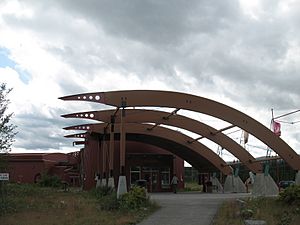
Yukon is also home to twelve National Historic Sites of Canada. These sites are also managed by Parks Canada. Five of them are located within national parks. The territory has many museums, such as the Copperbelt Railway & Mining Museum and the SS Klondike boat museum in Whitehorse. The Yukon Beringia Interpretive Centre in Whitehorse focuses on the ancient Beringia land bridge. Many businesses also let tourists experience the cultures of Yukon's First Nations and Inuit people.
Yukon's Culture and Arts
The Yukon has many cultural and sporting events that attract artists, locals, and tourists. Yearly events include the Adäka Cultural Festival, Dawson City Music Festival, and the Yukon Quest dog sled race.
Yukon's Indigenous culture is very important, especially in winter sports like the Yukon Quest sled dog race. The government also recognizes that First Nations and Inuit languages are a key part of the territory's cultural heritage. These languages include Tlingit and seven Athapaskan languages.
Yukon's Artists and Music
Famous Yukon artists include Jim Robb and Ted Harrison. Their paintings are well-known for showing life and culture in Yukon, both past and present.
During the Klondike Gold Rush, many folk songs about Yukon became popular. Examples include "Rush to the Klondike" and "I've Got the Klondike Fever."
The legacy of the Klondike Gold Rush (1897–1899) is a big part of Yukon's culture and tourism. It inspired writers like Jack London and Robert W. Service. It also continues to inspire movies and games today.
Getting Around Yukon: Transportation
Before modern transportation, rivers and mountain passes were the main travel routes. The coastal Tlingit people used them to trade with the Athabascans. Early Europeans also used these routes.
Air Travel
Erik Nielsen Whitehorse International Airport is the main airport in Yukon. It has regular flights to cities like Vancouver, Calgary, Edmonton, and Yellowknife. It also connects to smaller communities within Yukon, like Dawson City and Old Crow.
Railways
The railway in Yukon stopped running in the 1980s when the Faro mine closed. Now, it runs only during the summer for tourists. It travels between Carcross and Skagway, Alaska.
There are plans for a new railway line called the Alaska-Alberta Railway Development Corporation (A2A). This line would cross Yukon, connecting Watson Lake and possibly Carmacks.
Roads and Highways
Today, major roads include the Alaska Highway, the Klondike Highway, and the Haines Highway. The Dempster Highway connects Inuvik, Northwest Territories, to the Klondike Highway. It is the only road that reaches the Arctic Ocean in Canada. All these highways are paved except for the Dempster.
Other highways include the Robert Campbell Highway and the Silver Trail. The far-north community of Old Crow can only be reached by air travel.
Waterways
From the Gold Rush until the 1950s, riverboats traveled the Yukon River. They mostly went between Whitehorse and Dawson City. Some even went further to Alaska and the Bering Sea. Most of these riverboats were owned by the British-Yukon Navigation Company.
|
See also
 In Spanish: Yukón para niños
In Spanish: Yukón para niños



